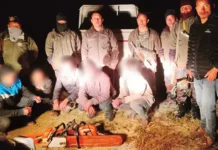[ Taba Ajum ]
A petition challenging the validity of Article 35A is causing restlessness in the troubled state of Jammu & Kashmir. The article bars outsiders from buying immovable property in the state. It empowers the Jammu & Kashmir legislature to define the state’s permanent residents and their special rights. The people of Kashmir valley are highly suspicious of the petition, and many believe that the right-wing nationalists are behind the move.
As a citizen of the state that is protected under the Bengal Eastern Frontier Regulation (BEFR) Act, 1873, which also prohibits outsiders from buying properties in the state, it worries me that these nationalists may next seek the removal of the BEFR.
Mainland Indians, especially the hyper nationalists, have always opposed the provision of the BEFR. History tells us that on several occasions they demanded that government of India remove this act. In a recent article in this daily, Dr Razzeko Dele, Assistant Professor at Jomin Tayeng Government Model Degree College, Roing, enlightened us on how the opposition parties tried to force the then prime minister Jawaharlal Nehru to settle 100,000 farmers from Punjab in the NEFA (Arunachal Pradesh) after the 1962 war with China, and how a socialist leader like Ram Manohar Lohia in protest against the inner line permit (ILP) system tried to forcibly enter the state without an ILP.
These are glaring examples of the deep hatred mainland Indians have for the ILP system. Imagine what might have be the situation in Arunachal had Nehru succumbed to the pressure of the opposition parties and allowed the settlement of farmers from Punjab? By now, just like Tripura, where the indigenous tribes have been reduced to a minority due to large-scale migration of Bengalis, Arunachal would have been in a similar situation.
These hyper nationalists do not understand the history behind the BEFR and Article 35A. States like Arunachal Pradesh and Jammu & Kashmir became part of India only after 1947. Before that they had their own identities, but sadly, the nationalists fail to recognize this uniqueness. Any move to scuttle the BEFR will have a catastrophic effect in Arunachal. Already the Chakma-Hajong refugees are seeking citizenship rights, which definitely will be followed by the demand for inclusion in the APST category and, perhaps later, land rights. Therefore, irrespective of political and ideological difference, every Arunachalee indigenous tribal citizen should always strive to protect the BEFR.
Today, states like Manipur and Meghalaya are demanding the ILP system to protect their respective states from the onslaught of outsiders. The citizens of the state should always remain indebted to a person like Verrier Elwin, who worked hard for the protection of the indigenous tribes and their rich culture. Though Elwin started his life in India as Christian missionary, during the later part of his career he spent a majority of his time in the NEFA, working for the preservation of the tribal culture, and was bitterly opposed to outsiders influencing the tribal way of life.
There are an incredible number of fascinating books written by people like Elwin, and several others published by the research department, documenting the early history of the state. These books give riveting information about how the tribal people of the state have evolved over the years. In this day of Facebook and WhatsApp, where fake news circulates like hot cakes, reading about the history of the state will freshen up our minds and also take us back to our roots.



